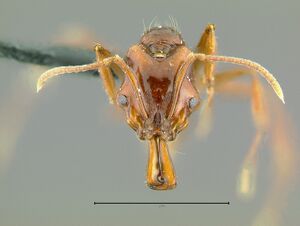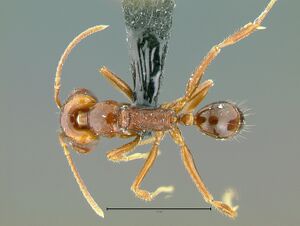Anochetus isolatus
| Anochetus isolatus | |
|---|---|

| |
| Scientific classification | |
| Kingdom: | Animalia |
| Phylum: | Arthropoda |
| Class: | Insecta |
| Order: | Hymenoptera |
| Family: | Formicidae |
| Subfamily: | Ponerinae |
| Tribe: | Ponerini |
| Genus: | Anochetus |
| Species: | A. isolatus |
| Binomial name | |
| Anochetus isolatus Mann, 1919 | |
| Synonyms | |
| |
This is a wide ranging species known from the Philippines south to the Solomon Islands and westward to the tip of Cape York Peninsula, Queensland. It is one of only two Australian Anochetus species which also occurs outside Australia. It is found in rainforest where it nests in rotten wood.
Identification
The distinctive shape of the petiolar node, being drawn dorsally into a narrow, blunt point, will separate this species from all others in Australia. Additionally, the pronotum is relatively narrower and the eye relatively smaller than in most other Australian species.
Keys including this Species
- Key to Australian Anochetus Species
- Key to the Anochetus Species of Asia, Melanesia and the Pacific Region
- Key to Anochetus of the Philippines
Distribution
Latitudinal Distribution Pattern
Latitudinal Range: 11° to -11.71667004°.
| North Temperate |
North Subtropical |
Tropical | South Subtropical |
South Temperate |
- Source: AntMaps
Distribution based on Regional Taxon Lists
Australasian Region: Australia.
Indo-Australian Region: Indonesia (type locality), New Guinea, Philippines, Solomon Islands (type locality).
Distribution based on AntMaps
Distribution based on AntWeb specimens
Check data from AntWeb
Countries Occupied
| Number of countries occupied by this species based on AntWiki Regional Taxon Lists. In general, fewer countries occupied indicates a narrower range, while more countries indicates a more widespread species. |

|
Estimated Abundance
| Relative abundance based on number of AntMaps records per species (this species within the purple bar). Fewer records (to the left) indicates a less abundant/encountered species while more records (to the right) indicates more abundant/encountered species. |

|
Biology
Castes
Worker
  
| |
| . | Owned by Museum of Comparative Zoology. |
Images from AntWeb
   
| |
| Syntype of Anochetus rossi. Worker. Specimen code castype06926-02. Photographer April Nobile, uploaded by California Academy of Sciences. | Owned by CAS, San Francisco, CA, USA. |
Queen
Images from AntWeb
   
| |
| Syntype of Anochetus rossi. Queen (alate/dealate). Specimen code castype06926-01. Photographer April Nobile, uploaded by California Academy of Sciences. | Owned by CAS, San Francisco, CA, USA. |
Nomenclature
The following information is derived from Barry Bolton's Online Catalogue of the Ants of the World.
- isolatus. Anochetus cato subsp. isolatus Mann, 1919: 302, fig. 11 (w.m.) SOLOMON IS (Santa Cruz).
- Type-material: syntype workers (number not stated, “several small colonies”).
- [Note: Baroni Urbani, 1973b: 143, cites 3w syntypes (1 without head) NHMB.]
- Type-locality: Solomon Is: Santa Cruz I., Graciosa Bay, 19.v.-24.xi.1916 (W.M. Mann).
- Type-depositories: MCZC, NHMB.
- Subspecies of cato: Wheeler, W.M. 1935g: 15.
- Status as species: Wilson, 1959a: 508; Taylor, 1976a: 80; Brown, 1978c: 557, 585; Bolton, 1995b: 64; Shattuck & Slipinska, 2012: 13 (redescription); Zettel, 2012: 158 (in key); Sarnat, et al. 2013: 73.
- Senior synonym of rossi Donisthorpe, 1949c: Brown, 1978c: 557; Bolton, 1995b: 64; Shattuck & Slipinska, 2012: 13.
- Senior synonym of splendens: Brown, 1978c: 557; Bolton, 1995b: 64; Shattuck & Slipinska, 2012: 13.
- Distribution: Australia, Indonesia (Aru), Papua New Guinea, Philippines (Luzon, Negros), Solomon Is.
- rossi. Anochetus rossi Donisthorpe, 1949c: 747 (w.q.) NEW GUINEA (Papua New Guinea).
- Type-material: 1 syntype worker, 1 syntype queen.
- Type-locality: worker Papua New Guinea: Finschafen, 27.iv.1944 (E.S. Ross); queen with same data but 12.v.1944.
- Type-depository: CASC.
- [Unresolved junior primary homonym of Odontomachus rossi Donisthorpe, 1947d: 186 (Bolton, 1995b: 65).]
- Junior synonym of isolatus: Brown, 1978c: 557; Bolton, 1995b: 65; Shattuck & Slipinska, 2012: 13.
- splendens. Anochetus splendens Karavaiev, 1925c: 289, fig. 11 (q.) INDONESIA (Aru Is).
- Type-material: holotype queen.
- Type-locality: Indonesia: Aru Is, Wammar I., 1912-13, Nr. 2673, at light (W. Karawaiew).
- Type-depository: SIZK.
- Status as species: Chapman & Capco, 1951: 42; Wilson, 1959a: 509.
- Junior synonym of isolatus: Brown, 1978c: 557; Bolton, 1995b: 65; Shattuck & Slipinska, 2012: 13.
Type Material
- Anochetus cato isolatus: Syntype, worker(s) and male(s), "several small colonies" from Graciosa Bay, Santa Cruz Island, Solomon Islands, Museum of Comparative Zoology.
- Anochetus rossi: Syntype, 1 worker, 1 queen, Finschhafen, Papua New Guiniea, California Academy of Sciences.
- Anochetus splendens: Holotype, queen, Wammar, Aru Island, Indonesia.
Taxonomic Notes
The concept of this species adopted by Shattuck & Slipinska (2012) follows that developed by Brown (1978), noting that Brown left many questions concerning the taxonomy of this species and close relatives unanswered. The specific specimens examined match each other very closely in sculpturing and show minimal variation in colour. However, a wide range of additional material is present in ANIC which varies from this pattern in the development of sculpturing and colour, most of which was outlined by Brown (1978). The true status of this and related species will require a detailed study of this additional material.
Description
Worker description. Sculpturing on front of head extending slightly beyond eyes. Scapes just reaching posterolateral corners ('lobes') of head; lacking or with a few short, inclined erect hairs. Pronotum and mesonotum smooth and shining. Dorsal surface of propodeum with transverse striations which extend laterally to the level of the spiracle and propodeal lobe. Propodeal angles rounded. Metanotal groove with coarse striations. Petiolar node drawn dorsally into a narrow point, lacking sculpture. Erect hairs on hind tibiae short, scattered and inclined. Colour dark brown, petiole, gaster and legs yellow to yellow-red, antennae, mandibles and posterior corners of head slightly lighter in colour than remainder of head capsule.
Measurements. Worker (n = 5): CI 86–90; EI 12–15; EL 0.15–0.20; HL 1.39–1.72; HW 1.25–1.49; HFL 1.14–1.38; ML 1.68–1.99; MandL 0.76–0.93; MTL 0.82–1.04; PronI 53–55; PronW 0.68–0.80; SL 1.09–1.29; SI 87–91.
References
- Brown, W. L., Jr. 1978c. Contributions toward a reclassification of the Formicidae. Part VI. Ponerinae, tribe Ponerini, subtribe Odontomachiti. Section B. Genus Anochetus and bibliography. Stud. Entomol. 20: 549-638 (page 557, senior synonym of rossi and splendens)
- Mann, W. M. 1919. The ants of the British Solomon Islands. Bulletin of the Museum of Comparative Zoology 63: 273-391 (page 302, fig. 11 worker, male described)
- Radchenko, A.G., Fisher, B.L., Esteves, F.A., Martynova, E.V., Bazhenova, T.N., Lasarenko, S.N. 2023. Ant type specimens (Hymenoptera, Formicidae) in the collection of Volodymyr Opanasovych Karawajew. Communication 1. Dorylinae, Poneromorpha and Pseudomyrmecinae. Zootaxa, 5244(1), 1–32 (doi:10.11646/zootaxa.5244.1.1).
- Shattuck, S.O. & Slipinska, E. 2012. Revision of the Australian species of the ant genus Anochetus (Hymenoptera Formicidae). Zootaxa 3426, 1–28.
- Wilson, E. O. 1959c. Studies on the ant fauna of Melanesia V. The tribe Odontomachini. Bulletin of the Museum of Comparative Zoology 120: 483-510 (page 508, raised to species)
References based on Global Ant Biodiversity Informatics
- Brown Jr., W.L. 1978. Contributions toward a reclassification of the Formicidae. Part VI. Ponerinae, Tribe Ponerini, Subtribe Odontomachiti, Section B. Genus Anochetus and Bibliography. Studia Entomologia 20(1-4): 549-XXX
- Brown W.L. Jr. 1978. Contributions toward a reclassification of the Formicidae. Part VI. Ponerinae, tribe Ponerini, subtribe Odontomachiti. Section B. Genus Anochetus and bibliography. Studia Ent. 20(1-4): 549-638.
- CSIRO Collection
- Chapman, J. W., and Capco, S. R. 1951. Check list of the ants (Hymenoptera: Formicidae) of Asia. Monogr. Inst. Sci. Technol. Manila 1: 1-327
- Donisthorpe H. 1949. A sixth instalment of the Ross Collection of ants from New Guinea. Annals and Magazine of Natural History (12)1: 744-759.
- Janda M., G. D. Alpert, M. L. Borowiec, E. P. Economo, P. Klimes, E. Sarnat, and S. O. Shattuck. 2011. Cheklist of ants described and recorded from New Guinea and associated islands. Available on http://www.newguineants.org/. Accessed on 24th Feb. 2011.
- Karavaiev V. 1925. Ponerinen (Fam. Formicidae) aus dem Indo-Australischen Gebiet. (Schluss). Konowia 4: 276-296.
- Karavaiev V. 1926. Ameisen aus dem Indo-Australischen Gebiet. Treubia 8: 413-445.
- Mann W. M. 1919. The ants of the British Solomon Islands. Bulletin of the Museum of Comparative Zoology 63:273-391.
- Mann, W.M. 1919. The ants of the British Solomon Islands. Bulletin of the Museum of Comparative Zoology of Harvard College 63: 273-391
- Shattuck S. O., and E. Slipinska. 2012. Revision of the Australian species of the ant genus Anochetus (Hymeoptera: Formicidae). Zootaxa 3426: 1-28.
- Taylor R. W. 1976. The ants of Rennell and Bellona Islands. Natural History of Rennell Island, British Solomon Islands 7: 73-90.
- Wheeler W.M. 1935. Check list of the ants of Oceania. Occasional Papers of the Bernice Pauahi Bishop Museum 11(11):1-56.
- Wheeler, William Morton.1935.Checklist of the Ants of Oceania.Occasional Papers 11(11): 3-56
- Wilson E. O. 1959. Studies on the ant fauna of Melanesia V. The tribe Odontomachini. Bulletin of the Museum of Comparative Zoology 120: 483-510.

